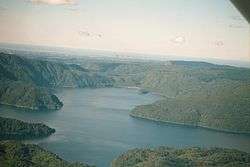Lake Okataina
| Lake Okataina | |
|---|---|
 Aerial view from the south | |
| Location | Bay of Plenty, North Island |
| Coordinates | 38°07′S 176°25′E / 38.117°S 176.417°ECoordinates: 38°07′S 176°25′E / 38.117°S 176.417°E |
| Type | crater lake |
| Basin countries | New Zealand |
| Max. length | 6.2 km[1] |
| Max. width | 5.0 km[1] |
| Surface area | 10.8 km2[1] |
| Average depth | 44.0 m[1] |
| Max. depth | 78.5 m[1] |
| Surface elevation | 311 m[1] |
| References | [1] |
Lake Okataina is the northernmost and largest of four smaller lakes lying between Lake Rotorua and Lake Tarawera in the Bay of Plenty region of New Zealand's North Island. The others are Lake Rotokakahi (Green Lake), Lake Tikitapu (Blue Lake), and Lake Okareka. All lie within the Okataina caldera, along its western edge.
Unlike many other lakes in the region, Lake Okataina is completely encircled by native forest. It also has no inlets or outlets. Perhaps as a result, over the past 30 years, the level of the lake has risen and fallen in a range of about 5 metres.
The lake can be accessed by road via Hinehopu on the southern shores of Lake Rotoiti. At the end of the road there is a large sandy beach, a massive grassed area and the privately owned Okataina Lodge. Due to changes in the surface level of the lake, the lodge jetty has at times been either completely submerged or left high and dry.
The area around the lodge is, to the surprise of many, heavily populated by tammar wallabies introduced from Australia in the 19th century.[2]
References
External links
-
 Media related to Lake Okataina at Wikimedia Commons
Media related to Lake Okataina at Wikimedia Commons